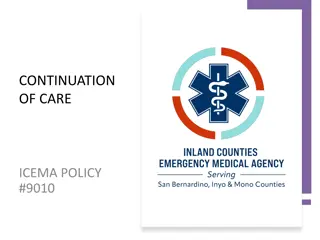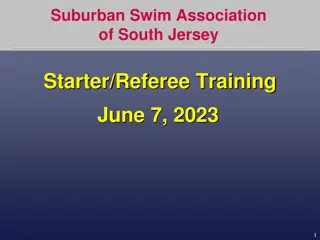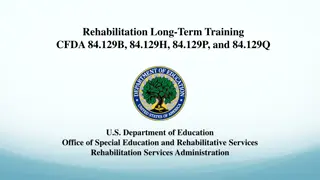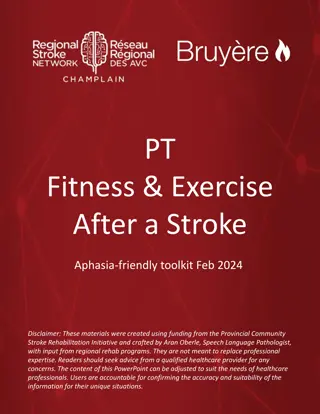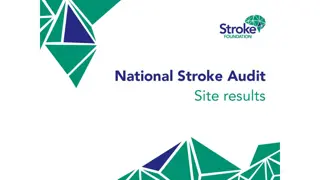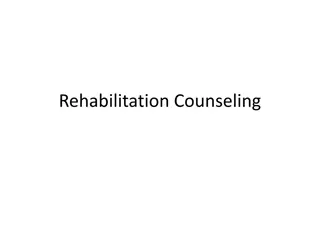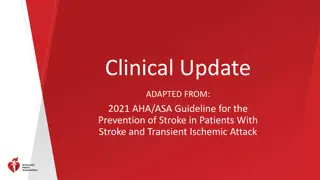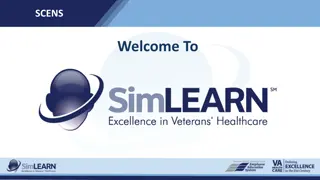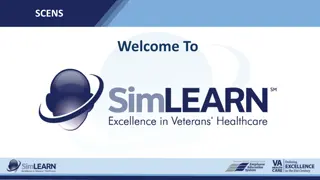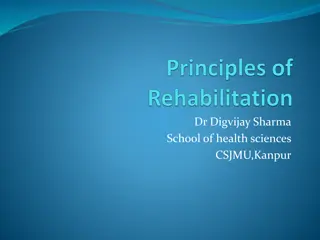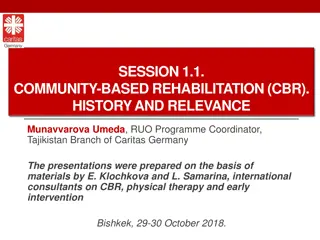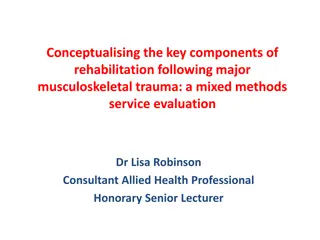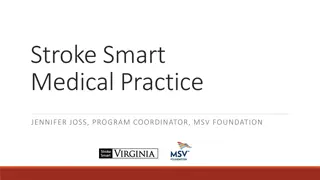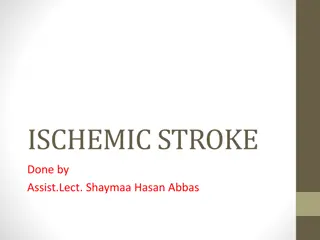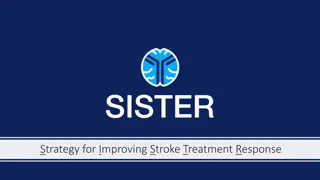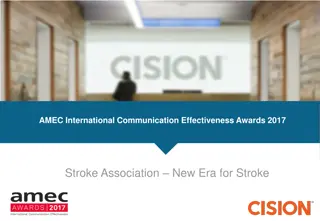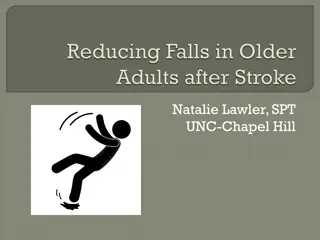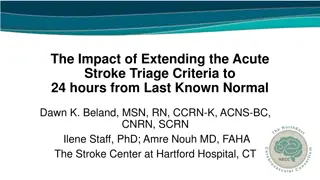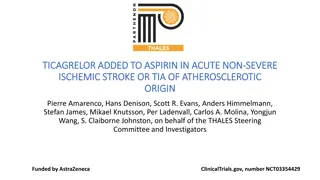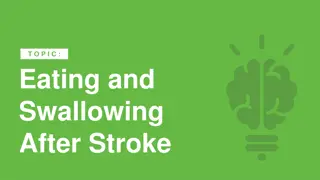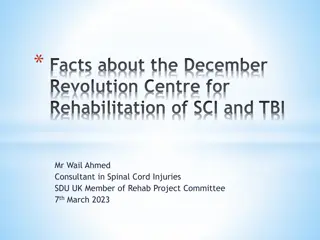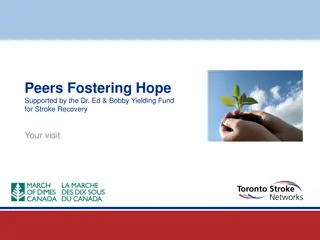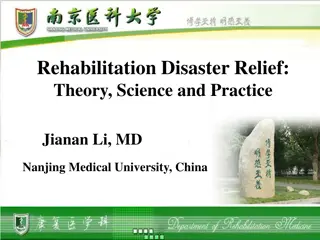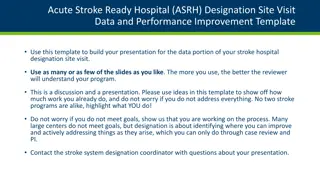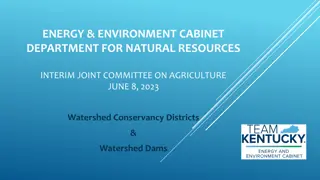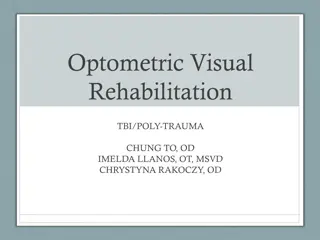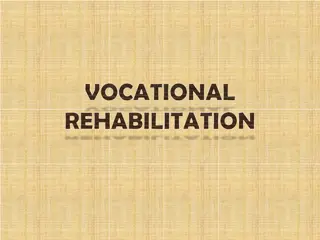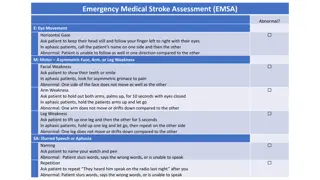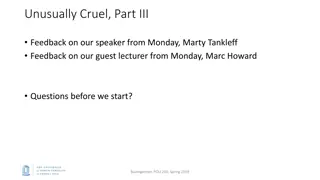Automated CT Perfusion Imaging in Acute Ischemic Stroke: Overview
This presentation delves into the significance of automated CT perfusion imaging in diagnosing and treating acute ischemic stroke. It covers essential information such as the burden of stroke in Ontario, the critical aspect of time in stroke treatment, hyperacute stroke treatment goals, and the impo
4 views • 41 slides
ICEMA Policy #9010: Continuation of Care for Urgent Patient Transfer
This policy outlines the procedures for rapid transport and transfer of patients requiring urgent care to Specialty Care Centers by ICEMA Continuation of Care EMS Providers and Referral Hospitals. It includes criteria for Specialty Care Centers acceptance of trauma, STEMI, and stroke patients, desig
1 views • 28 slides
Swimming Stroke Rules and Regulations Training
Learn about the rules and regulations of swimming strokes, including backstroke and breaststroke techniques. The training covers key aspects such as stroke review, host and visiting team responsibilities, meet officials' duties, and scorekeeping. Understand the specifics of backstroke starts, finish
4 views • 50 slides
Understanding Basic CT Perfusion Terms in Stroke Imaging
This educational content delves into fundamental concepts related to CT perfusion imaging in stroke evaluation. It covers key terms such as core infarct, penumbra, Time to Peak, Mean Transit Time, Cerebral Blood Volume, and more. The information includes definitions, descriptions, and the significan
6 views • 16 slides
Rehabilitation Long-Term Training Program Overview
The Rehabilitation Long-Term Training Program, managed by the U.S. Department of Education, aims to address personnel shortages in vocational rehabilitation services for individuals with disabilities. It offers academic training, particularly in vocational rehabilitation counseling, to enhance emplo
1 views • 30 slides
SISTER Study: Improving Stroke Treatment Response with TS23
SISTER Study led by Eva Mistry aims to identify a safe and effective dose of TS23 for treating ischemic stroke patients with core-penumbra mismatch. The Phase-2 trial involves 300 adults and spans 54 months, with primary endpoints focusing on treatment efficacy and safety. The study is randomized, p
0 views • 22 slides
Fitness and Exercise After Stroke: Importance and Guidelines
Understanding the importance of fitness and exercise in stroke recovery is crucial due to the varied challenges individuals face post-stroke. This toolkit provides information on the impact of stroke, the benefits of exercise, types of exercises recommended, and different exercise program options av
2 views • 11 slides
Hospital Stroke Care Audit 2023 Presentation
Customize your hospital's stroke care audit presentation using the provided template. Add your hospital's data to create an interactive slide deck for sharing with your team and stakeholders. The National Stroke Audit Acute Services 2023 focuses on assessing resources and clinical care indicators ag
23 views • 15 slides
Understanding Rehabilitation Counseling in the Professional Setting
Rehabilitation counseling is a specialized field within the rehabilitation professions that focuses on assisting individuals with disabilities to achieve personal, career, and independent-living goals. It involves a systematic process that aims to maximize employability, independence, integration, a
2 views • 15 slides
Clinical Update: 2021 AHA/ASA Guideline for Stroke Prevention
This clinical update provides guidance adapted from the 2021 AHA/ASA Guideline for the Prevention of Stroke in Patients with Stroke and Transient Ischemic Attack. It categorizes recommendations based on strength and quality of evidence, outlining levels of recommendation and evidence for different c
0 views • 43 slides
Comprehensive Guide to Stroke Care: SCENS Protocol Overview
This comprehensive guide delves into the SCENS protocol for stroke care, covering learning objectives, reasons for implementation, major stroke types, risk factors, the 8 Ds of stroke care, important time goals, and the FAST assessment process. It emphasizes the importance of early detection, swift
3 views • 20 slides
Comprehensive Stroke Program Orientation for Medical Staff - Facts and Objectives
The Comprehensive Stroke Program provides crucial information for medical staff, covering acute stroke response, available stroke codes, and responsibilities during inpatient care. Stroke facts highlight the prevalence, causes, risk factors, and complications associated with strokes. Details on lacu
0 views • 22 slides
Comprehensive Stroke Care Protocol and Time Goals Overview
This presentation details the SCENS protocol for stroke care, including learning objectives, major types of strokes, risk factors, 8 Ds of stroke care, and important time goals to achieve optimal patient outcomes.
0 views • 19 slides
Principles of Rehabilitation in Healthcare
Rehabilitation is centered on empowering individuals to take charge of their health, recognizing their inherent worth as unique entities. Understanding and implementing the seven principles of rehabilitation - Avoid aggravation, Timing, Compliance, Individualization, Specific sequencing, Intensity,
0 views • 15 slides
Community-Based Rehabilitation: Empowering Inclusive Development
Community-Based Rehabilitation (CBR) is a strategy that originated in 1978 as a means to enhance access to rehabilitation services for individuals with disabilities in developing nations. Over the years, CBR has evolved into a holistic approach for fostering inclusive community development. By decen
0 views • 25 slides
ACST-2 Trial: Stenting vs. Surgery for Carotid Artery Stenosis
ACST-2 is a randomized trial comparing carotid artery stenting (CAS) versus carotid artery surgery (CEA) in asymptomatic patients with severe carotid stenosis. The trial, published in The Lancet in August 2021, involved 3625 patients. While surgery has been shown to reduce stroke rates, modern medic
0 views • 19 slides
Evaluation of Rehabilitation Components for Musculoskeletal Trauma
This evaluation focuses on the rehabilitation needs of individuals with major musculoskeletal trauma, aiming to identify, prioritize, and enhance services. The project involves generating ideas, sorting and rating statements, and mapping key components such as long-term support, therapy input, and e
0 views • 15 slides
Rehabilitation Considerations During the COVID-19 Outbreak
Rehabilitation services during the COVID-19 pandemic are crucial for continuing essential care and optimizing outcomes, especially for individuals with severe COVID-19 cases. Considerations for non-COVID-19 rehabilitation services must be maintained to address acute injuries, post-surgical recovery,
0 views • 14 slides
Role and Impact of Rehabilitation Council of India (RCI) in Education and Training
The Rehabilitation Council of India (RCI) plays a crucial role in regulating training programs, setting standards for professionals, recognizing institutions, promoting research, maintaining registers, and encouraging continuing education in the field of rehabilitation. Established as a statutory bo
1 views • 8 slides
Stroke Smart Medical Practice - Empowering Awareness and Early Intervention
Discover the Stroke Smart Medical Practice initiative aimed at enhancing stroke awareness, recognizing signs, and ensuring timely intervention. Uncover key statistics, warning signs, treatment predicaments, and the history behind this vital program. Join the movement to educate patients and medical
0 views • 17 slides
Comprehensive Treatment Guidelines for Acute Ischemic Stroke
In the management of acute ischemic stroke, the primary goals are to reduce secondary brain damage, maintain adequate perfusion, and prevent recurrent strokes by managing risk factors. Treatment includes maintaining tissue oxygenation, correcting volume status and electrolytes, managing blood glucos
0 views • 20 slides
Comprehensive Approach to Enhancing Stroke Treatment Response
Enhance stroke treatment response by focusing on strategies, training, contacts, learning goals, and processes. Understand the screening criteria, consent process, inclusion criteria, and steps for site readiness. Key contacts for project management and training are provided for a successful stroke
0 views • 52 slides
Stroke Association Campaign: Driving Change for Stroke Awareness
The Stroke Association's campaign aimed to raise awareness and lobby the government for a new stroke strategy. Through strategic communication efforts, including petitions, media engagement, and famous landmarks turning purple, the campaign successfully reached key audiences, gained petition signatu
0 views • 5 slides
Understanding Stroke-Specific Etiologies and Interventions for Falls in Inpatient Rehabilitation
Falls are a common complication after stroke, leading to hip fractures and various secondary complications. Inpatient rehabilitation often focuses on interventions to reduce stroke-related falls, considering factors like muscle tone, cognitive impairments, and balance deficits. Understanding these s
1 views • 27 slides
Impact of Extending Acute Stroke Triage Criteria to 24 Hours
Landmark trials have extended the therapeutic time window for mechanical thrombectomy for acute ischemic stroke patients. This study evaluates the impact of implementing a protocol change to extend the time window at a comprehensive stroke center. Retrospective analysis compared stroke alerts and ke
1 views • 8 slides
Ticagrelor Added to Aspirin in Acute Non-Severe Ischemic Stroke or TIA of Atherosclerotic Origin
Among patients with transient ischemic attack (TIA) or minor ischemic strokes, adding ticagrelor to aspirin has shown superior efficacy in preventing stroke or death, particularly in those with ipsilateral atherosclerotic stenosis. The THALES trial demonstrated that ticagrelor added to aspirin was m
0 views • 14 slides
Advances in Anticoagulation Therapy for Cancer-Related VTE and Stroke
Recent studies have shown advancements in anticoagulation therapy for cancer patients with venous thromboembolism (VTE) and stroke prevention. Direct oral anticoagulants (DOACs) are now considered beneficial for treating VTE in cancer, offering advantages in administration and efficacy. Different an
3 views • 9 slides
Evaluation of Risk Stratification Schemes for Ischaemic Stroke and Bleeding in Atrial Fibrillation Patients
A study conducted in Sweden on 182,678 patients with atrial fibrillation aimed to investigate risk factors for stroke and bleeding. The research assessed the application of CHA2DS2-VASc and HAS-BLED schemes for stroke and bleeding risk evaluations. Data from the Swedish Atrial Fibrillation cohort st
0 views • 20 slides
Managing Eating and Swallowing Challenges After Stroke
Dysphagia, a common issue after a stroke, can lead to difficulty swallowing and may require texture modifications in food and fluids for safety. Up to 65% of stroke survivors may experience dysphagia, which can lead to complications like pneumonia. Proper oral care, mealtime positioning, and awarene
0 views • 9 slides
Development of a Tertiary Neurological Rehabilitation Centre in Sudan
The December Revolution Centre for Rehabilitation of Traumatic Spinal Cord and Brain Injuries at Khartoum Teaching Hospital addresses the lack of holistic patient-centered rehabilitation services in Sudan. Following the December 2018 Revolution, the need for specialized care for victims with spinal
0 views • 11 slides
Stroke Recovery Peer Support Program Guidelines
Learn about the "Peers Fostering Hope Supported by the Dr. Ed & Bobby Yielding Fund for Stroke Recovery" initiative aiming to re-engage and re-integrate stroke survivors into the community. Explore how peer visitors provide support, encouragement, and hope for community re-engagement and reintegrati
1 views • 16 slides
State of Nevada Department of Employment, Training, and Rehabilitation Budget Summary 2019-2021
The Governor's requested budget for the Rehabilitation Division of the Nevada Department of Employment, Training, and Rehabilitation focuses on promoting barrier-free communities for individuals with disabilities to access competitive employment opportunities. The Division oversees various bureaus s
0 views • 12 slides
Rehabilitation Disaster Relief: Theory, Science, and Practice
Challenges in Rehabilitation Disaster Relief include lack of extensive rescue capacity, rehab resources and management, fund shortages, and uncoordinated implementation. ISPRM-RDRC outlines past and future actions focusing on the NHV model, mobile rehab teams, international rehab databases, rehab st
0 views • 21 slides
Enhancing Stroke Program Performance: ASRH Designation Site Visit Data & Improvement
Explore the data presentation template for an Acute Stroke Ready Hospital (ASRH) designation site visit, focusing on key metrics like door-to-activation times and imaging procedures. Evaluate trends, showcase improvements, and address future plans for quality enhancement. Consider additional trackin
0 views • 11 slides
Watershed Conservation and Dam Rehabilitation Initiatives Overview
Explore the functions and responsibilities of Watershed Conservancy Districts in maintaining watershed dams, the funding mechanisms for dam rehabilitation projects, and the prioritized dam rehabilitation initiatives in Kentucky. Learn about the Watershed Dam Fund and its role in supporting the rehab
0 views • 8 slides
Optometric Visual Rehabilitation for TBI/Poly-Trauma Patients: Principles and Considerations
Optometric Visual Rehabilitation involves the comprehensive treatment of visual system disorders, including binocular vision, accommodation issues, and more. Neural plasticity plays a key role in neuro-rehabilitation, allowing the brain to adapt and learn. The 10 principles of neural plasticity guid
0 views • 29 slides
Understanding Vocational Rehabilitation for Individuals with Disabilities
Vocational rehabilitation is a multidisciplinary process aimed at helping individuals with disabilities reintegrate into society through job placement. This involves assessing hand functions, planning rehabilitation, and identifying suitable vocations based on individual abilities. Rehabilitation pl
0 views • 21 slides
Emergency Medical Stroke Assessment (EMSA) Abnormal Signs & Evaluation
This comprehensive guide outlines the Emergency Medical Stroke Assessment (EMSA) protocol for assessing potential stroke patients. It covers the evaluation of abnormal signs related to eye movement, motor weaknesses in the face, arms, and legs, as well as slurred speech or aphasia. The assessment in
0 views • 9 slides
Stroke Continence Protocols for Managing Bladder and Bowel Function After Stroke
This protocol outlines the management of urinary and bowel incontinence in stroke patients, emphasizing high nursing care levels and avoiding unnecessary catheterization. It discusses normal bladder functions, urinary dysfunction prevalence post-stroke, and interventions for promoting continence. Ur
0 views • 30 slides
Comparative Perspectives on Sentencing and Rehabilitation in Criminal Justice Systems
Exploring the historical context and current practices in sentencing and rehabilitation within criminal justice systems, the discussion covers topics such as the evolving forms of sentencing in the US, the impact of drug sentencing in Portugal, disparities in punishment among different countries, pr
0 views • 11 slides

